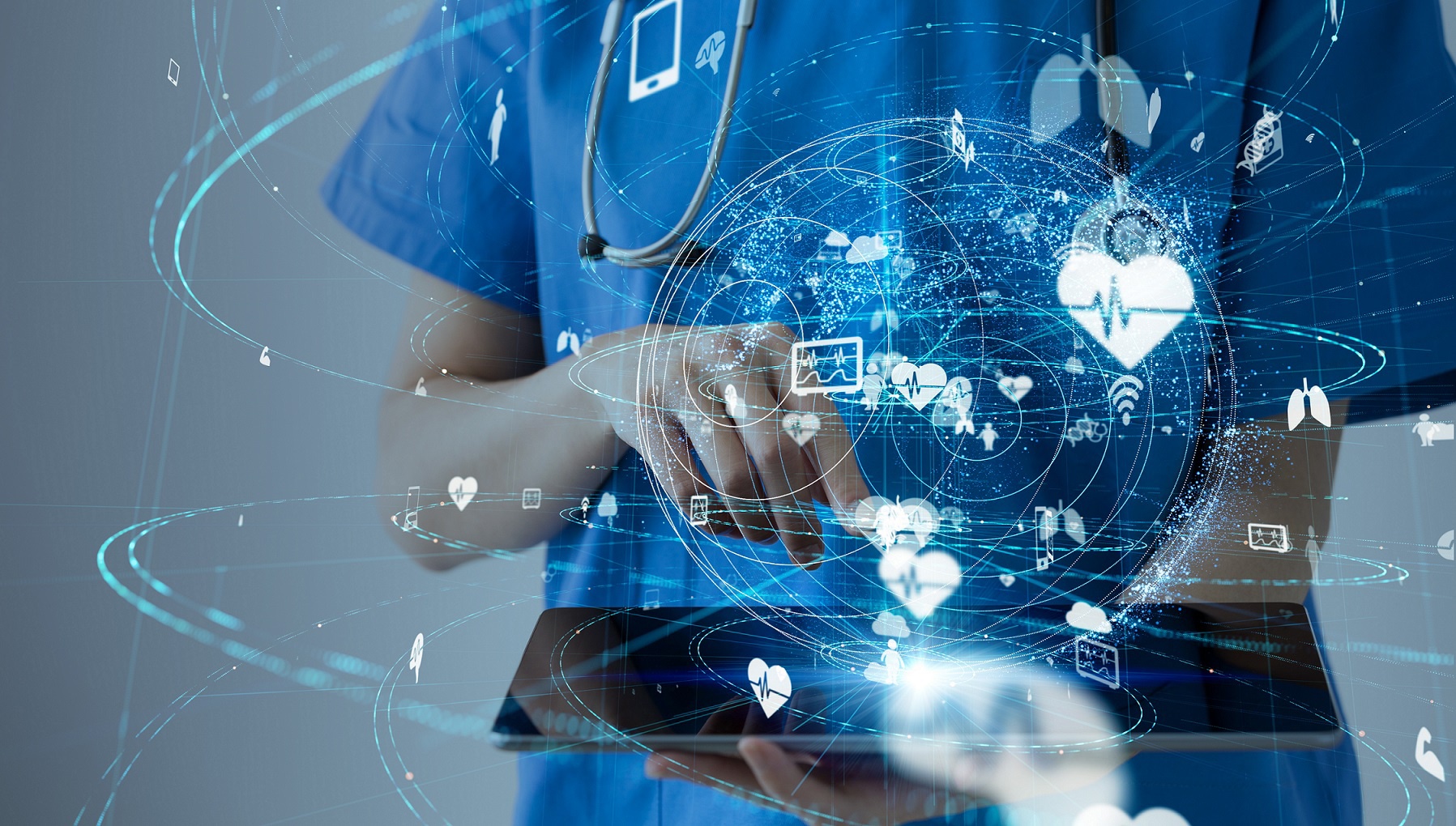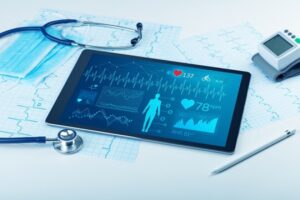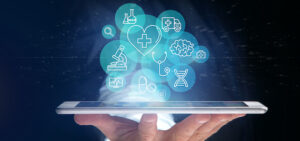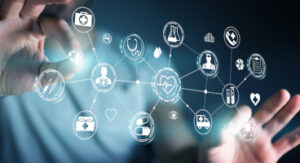Marina
02.02.2023
Categories

12 Digital Healthcare Trends for 2023 and Beyond

Marina
02.02.2023
Healthcare has become more digitalized over the years thanks to advancements in technology and connectivity between patients, doctors, and hospitals. The era of COVID-19 changed the world of hospital care by making medical records accessible via smartphones or computers. People now can access their information from anywhere at any time without having to wait for an appointment at their doctor’s office.
In this article, we’ll look at 12 trends shaping digital healthcare development over the next decade — from a rise in consumerism to more personalized approaches to treating patients — and what it means for your business today and tomorrow.
You may have heard of these trends and even tried to implement them into your practice. Let’s review the six digital trends that will shape the quality of healthcare:
As the healthcare industry continues to digitize and become more data-driven, data science has become a critical component of modern medicine. Data science is an interdisciplinary field that focuses on extracting knowledge from large amounts of data, among other things. It commonly uses machine learning (ML), artificial intelligence (AI), reinforcement learning (RL), and natural language processing (NLP).
In 2023, data science will be used to get even more insight into health systems. For example:
These technologies will be used for more efficient diagnosis, monitoring, and treatment of patients by combining them with other tools like radiographic imaging devices or wearable sensors that measure vitals (blood pressure or body temperature) at regular intervals throughout the day.

As healthcare becomes more personal and consumers take control of their care, providers are increasingly using digital technologies to collect and process healthcare data. The trend toward consumerization has led to the emergence of a new generation of technology companies that focus on providing solutions for consumers’ needs.
One example of this trend is personalized medicine — using genetic information or other biomarkers (biological indicators) as part of treatment decisions at individualized levels. With advances in genomics research, we now know many factors affect our risk for developing certain diseases or conditions, including genetic variations and lifestyle choices like smoking or drinking alcohol.
As another example, consider how Fitbit helps people manage their fitness goals by tracking activity levels throughout the day. It helps them identify areas where they can improve, so they can meet their goals. This type of self-monitoring has been shown to improve health outcomes by increasing awareness around overall wellness and encouraging positive lifestyle changes like eating better or exercising more often.
Cloud technologies are also transforming healthcare and offer significant advantages over traditional systems:
Cloud computing helps increase efficiency and reduce costs by automating processes, enabling better management of data, supporting remote treatment options, and providing access to medical records anytime, anywhere. Examples of cloud technologies include:
With cloud-based solutions, care providers are no longer required to keep expensive paper records that need constant updating and time-consuming manual entry into a database by staff members. Cloud computing in healthcare will provide solutions by opening new channels to reach patients and accelerating personalized care to continuously improve patient outcomes.
As the healthcare industry moves forward with telemedicine and other digital healthcare solutions, the question of data security becomes increasingly important. With so much sensitive information being transmitted over networks and stored in databases, there are many potential threats posed by hackers.
If you don’t protect your data properly, it could be exposed to unauthorized users who could use it for malicious purposes or sell it on black markets. For example:
So how can you ensure that your data is secure? The answer lies in implementing strong cybersecurity measures that meet regulatory requirements so that you don’t run afoul of any laws regarding privacy or confidentiality. For example, host health data with health data compliance certification like HDS in France or HIPAA in the US — and implement other best practices, like two-factor authentication processes, where possible.
Automation is a major trend in digital healthcare. The growing prevalence of ML and AI solutions will allow healthcare professionals to perform many tasks without human intervention, freeing them up for more complex tasks and improving patient care.
Automation in healthcare includes:
Automation can be a boon for healthcare professionals who are often overwhelmed by the demands of their jobs. AI-powered tools like chatbots may also recommend follow-up appointments with doctors based on the answers provided by patients.
Patient portals can be used differently: for accessing basic information like test results or medications, or as an extension of a healthcare provider’s office — by communicating with physicians through the portal instead of making an appointment at their clinic. Patients can also receive reminders about upcoming appointments, medication refills, or physical exams.
Patient portal features may vary depending on the provider’s electronic health record system but typically include:
Those who use a patient portal can also upload information about their medical history and provide additional details about their family members. It can help physicians keep track of children’s growth and development and allergies or other health conditions that may be pertinent to the care they’re providing.

The healthcare sector is changing rapidly, and RoveTek has been witnessing some of these changes over the past few years. Many other trends will shape how we perceive eHealth in 2023 and beyond.
RoveTek would like to share with you an additional six eHealth trends for 2023 where we see significant opportunities for growth:
According to a report from MarketsandMarkets, the global digital health market is expected to grow at a CAGR of 19% and reach over $970 billion by 2027. The demand for tools to deliver remote services or “remote care” will increase, particularly for behavioral health because these patients tend to prefer online treatment to face-to-face interactions with their doctors or therapists. Digital health leads to growth in the eHealth digital products market segment that features high competition due to many players trying their hands at developing innovative solutions that meet patient needs better than traditional ones.
Digital Health also leads entrepreneurs who want their ideas implemented, so they can create new start-ups and healthcare organizations focusing on delivering remote services or products through technology platforms like:
Digital health apps have proven to be popular and profitable, making now the right time for investors to consider this industry.
As virtual health is on the rise, more patients will access healthcare, and more data will be stored in the cloud. It will require new ways of managing and analyzing information. Al helps healthcare process Big Data and delivers personalized care to patients.
Al Robotics is already used in nursing and caregiving. For example, robots can assist doctors with surgical procedures by performing tasks like holding tools or moving patients around during surgery. They may also monitor vital signs during operations so that surgeons don’t have to leave their workstations at critical moments.
One of the most well-known Al technologies in medicine is chatbots. They use NLP technology to communicate with users over text messages, web browsers, or mobile apps. By asking questions about symptoms, chatbots can recommend treatment options based on previous cases.
Algorithms are used to analyze blood test results. Based on biomarkers like age and percentage of lymphocytes, they can predict a patient’s likelihood of surviving diseases like COVID-19. In the future, these technologies will allow doctors to analyze samples without specialized laboratories or having them sent somewhere else.
The Internet of Medical Things (loMT) and wearable devices are the latest and most popular trend in digital healthcare. The necessity of distance care has been caused by various factors, like urbanization, the aging population, and increasing demand for higher-quality services.
IoMT for the elderly is one of the most demanding applications, as the population of the US and Europe is aging fast. With wearables, doctors can take care of their patients from a distance without leaving their homes or offices. The COVID-19 pandemic showed us how important it is to get access to healthcare delivery services from home.
There are over 1.1 billion connected wearable devices in the world. The most popular wearable technologies today include fitness trackers and weight-monitoring devices. However, there are many other applications available, too. For example, glucose monitors are a great way to keep an eye on your diabetes.

Telemedicine is a healthcare trend that allows patients to get consultations anywhere with a stable Internet connection and access to video chat platforms. The global telemedicine market is expected to reach $455 billion by 2023, growing at a compound annual growth rate (CAGR) of 24%. As more people become aware of this service, it will continue to grow over time.
Telemedicine has many benefits for both providers and patients alike. It’s easy for providers because they don’t have to travel long distances or worry about scheduling appointments around their other duties. Telehealth visits are more convenient for patients who may not be able to afford regular visits or take time off work. Finally, telehealth solutions save money by reducing travel costs associated with seeing a doctor in person every visit. Senior citizens can especially benefit from this type of service.
VR and AR are set to transform the future of healthcare. According to Statista, the global revenue generated by VR and AR technologies is expected to increase from $31 billion in 2023 to $52 billion by 2027.
These technologies can model different conditions and situations, allowing medical professionals to practice procedures before they perform them on real patients. In surgery practices, VR technologies are used before and after surgery for improved patient experience and better recovery times. It also helps reduce costs associated with training staff members due to fewer mistakes made during operations when using these types of simulations.
In education settings, VR technology helps medical professionals improve their skills through 3D simulation exercises that mimic real-life scenarios. They can help imitate emergencies in operating rooms or battlefield situations where soldiers need immediate treatment after being injured by an enemy.
The mobile health market is growing rapidly due to increased consumer demand for convenience and improved access to healthcare services. The global mHealth market size is valued at around $49 billion in 2023 and is expected to grow at an annualized rate of 11% over the next five years.
Many people use fitness trackers and apps as training coaches, which help them achieve their goals faster and easier. The medical or wellness mobile apps can be:
Hospitals can use wellness apps for appointment management, hospital or doctor selection, and providing content like educational materials about diseases.
In today’s world, technology has become an integral part of our daily lives. With the rapid development of mobile technologies and the internet, people can access health information quickly and easily from anywhere in the world. It has led to a huge increase in demand for digital healthcare solutions — and this trend isn’t going away anytime soon.
Visiting your doctor on mobile or studying surgery with the help of 3D is no longer a top-notch trend but a new reality of medical care. The RoveTek team can help you create a unique website or mobile app that will change the way people interact with their doctors. We provide solutions in web & mobile development, focusing on building custom software solutions that meet all the needs of our clients from hospitals to healthcare apps.
Now that you know what to look out for, let’s start a journey of digital transformation for your healthcare project with RoveTek!